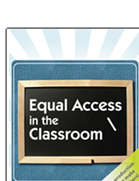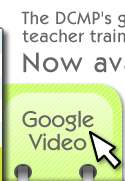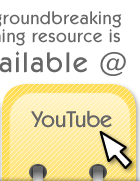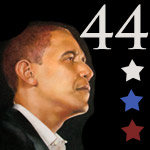Having trouble reading this newsletter?
View our Web version in your browser.



In this issue: |
Barack Obama | Presidents Day | Presidential Facts |
skip to quick hits
Special Focus: The Presidency
From the Inauguration of the next U.S. President to the upcoming Presidents Day (February 16th) observance, there sure is a lot of focus on the Executive Branch these days. This month’s DCMP newsletter features information for teachers and parents looking to incorporate the new President, the Inauguration, and the Presidency itself into their lesson planning through captioned and described media. Barack Obama: The 44th President of the U.S.A.Back to article listing
At noon on January 20th, President-elect Barack Obama will take the oath of office and become the 44th President of the United States of America. President-elect Obama’s campaign devoted significant resources to expressing the candidate’s strong committment to disability issues. You can even share your own story and suggestions for what you'd like to see the Obama administration do with regard to disabilities issues. Most of the anticipated 4 million Inauguration attendees will be watching the events on large television screens erected around the National Mall. (In addition to open captioning, ASL interpretation will be provided for attendees who are deaf or hard of hearing, and live description will be provided for those with visual impairments.) Why not beat the traffic and traditionally chilly weather by watching the inauguration live on PBS? For the fifth consecutive inauguration, WGBH will provide live captions and description during PBS’s NewsHour coverage of the Inauguration. (HINT: use PBS’s “Station Finder” and contact your local PBS affiliate to confirm that they will be passing through the description and captioning for the Presidential inauguration. Make sure to test—or learn how to enable—these features in advance so that you are familiar with using them on Inauguration day.) 
Presidents Day 2009Back to article listing
Presidents Day (officially known as Washington’s Birthday in honor of the 1st President’s birthday—February 22nd) is celebrated every February. This year, we observe the 200th birthday of one of our most famous Presidents, Abraham Lincoln, born on February 12th, 1809. Here are some of the Presidency-related titles available from the DCMP (with applicable grade levels identified in parentheses): Overviewing the Presidency…
“Our Presidents in America’s History” Series…
In honor of Abraham Lincoln’s 200th birthday…
Fun Stuff…
(HINT: You may also want to check out some videos and related resources from PBS’s “The Presidents” series offered for free for a limited time. All of the videos include captioning, and the FDR includes open description.) Presidential Facts: The Presidency and Hearing/Vision LossBack to article listingSince we’re focusing on the Presidency this month, here are some bits of trivia we’ve uncovered related to Presidential support for Americans with vision or hearing loss: We begin back in 1864, when President Abraham Lincoln signed a bill into law authorizing Amos Kendall’s school in Washington D.C. to award college degrees. This institution, known today as Gallaudet University (after a 1954 act of Congress), still honors the tradition that began in 1869—during the administration of Ulysses S. Grant—whereby each college diploma is signed by the sitting President of the United States. In 1879, President Rutherford Hayes signed the Act to Promote the Education of the Blind, which created the American Printing House for the Blind (APH). In 1931 the Pratt-Smoot Act was signed by Herbert Hoover and provided funding for what would become the National Library Service for the Blind and Physically Handicapped (NLS). It was amended in 1939 to provide talking books as well as braille materials. Part of the “New Deal” coordinated by President Franklin D. Roosevelt (who was, himself, visually impaired due to complications of polio) The Social Security Act, in 1935, introduced a relief category—Title X—for people who were blind as well as defining “legal blindness.” FDR’s memorial in Washington D.C. was designed to reflect FDR’s commitment to disability issues, as well as his own disabilities—there are braille representations on various monument elements and the entire exhibit is designed as a tactile experience meant to be touched. Speaking of the Roosevelts, President Theodore Roosevelt, who served from 1901–1909 as the nation’s 26th President, was blind in his left eye as the result of a boxing accident in the White House, a fact first made public in his obituary in the New York Times [PDF]. In 1958, President Dwight D. Eisenhower signed Public Law 85-905 [PDF]. With the President’s signature, Captioned Films for the Deaf (an ancestor to the DCMP) saw its first Federal support, which was also the first Federal support for captioning. President Eisenhower was so impressed with CFD’s efforts that he wrote a letter in support of the program [PDF] in 1960. President Lyndon Johnson signed the 1965 Elementary and Secondary Education Act (ESEA), which has been reauthorized every five years since its passage, most recently in the No Child Left Behind Act (NLCB). President Johnson was also the first President to declare October 15 as “National White Cane Safety Day,” a tradition that has been repeated by each successive U.S. President. President Richard Nixon signed the 1973 Rehabilitation Act, a landmark piece of disability legislation that was reauthorized in 1990 as the Americans with Disabilities Act (ADA) with the signature of President George H.W. Bush. President Gerald Ford signed the Education for All Handicapped Children Act in 1974, which included the first educational definition of a visual impairment. This act was the precursor to the modern Individuals with Disabilities Education Act (IDEA), which provides funding for the DCMP’s services. In 1993, President Bill Clinton appointed Judith E. Heumann, a longtime disability rights activist who is visually impaired, to be Assistant Secretary of the Office of Special Education and Rehabilitation Services (OSERS) at the U.S. Department of Education. Under President George H.W. Bush, this position was held by Robert Davila—a deaf man—who, in 2007, became the ninth president of Gallaudet University. |

ALA’s “WINDOW TO A LARGER WORLD” REPORT SUBMITTED TO PRESIDENTIAL TRANSITION TEAMThe American Library Association (ALA) met with President-elect Obama’s transition team to discuss key issues and concerns regarding the important role of libraries in American life. Following these meetings, the ALA submitted a detailed report [PDF] outlining the library’s role in a changing America. 

CELEBRATE DR. MARTIN LUTHER KING JR. DAYJanuary 19th is the Martin Luther King, Jr. Day of Service. Since 1994, the national holiday celebrating the life of perhaps the most important and influential civil rights leader in U.S. history has been dedicated to encouraging Americans to contribute to their communities. Check out the DCMP’s titles about Dr. Martin Luther King Jr. and read the NAD’s press release [PDF] encouraging its members and affiliates to get involved in the Day of Service. 

FEBRUARY IS BLACK HISTORY MONTHRead an article about Black History Month [PDF] written by DCMP’s own Kathy Buckson and download/print our Black History Month flyer [PDF] for a listing of suggested DCMP titles about Black History. For more on Black History Month, visit the Web site of the Association for the Study of African American Life and History (ASALH). 

AMERICAN COUNCIL OF THE BLIND LAUNCHES AUDIO DESCRIPTION PROJECTThe ACB has announced the establishment of its Audio Description Project (ADP), an effort by which ACB and its partners intends to raise public awareness of (and support for) description in theater, television, movies, and on the Internet. Read the ACB press release about the ADP and watch the DCMP newsletter for future announcements. 
|




|
The Described and Captioned Media Program is funded by the U.S. Department of Education and administered by the National Association of the Deaf. |
Visit the DCMP Web Site |
This newsletter is distributed to DCMP clients and other interested persons.
If you received this newsletter as an e-mail forward or found it on the Web, and you would like to sign up to receive the semi-monthly DCMP newsletter, please visit our sign-up page on DCMP.org.
~words~


